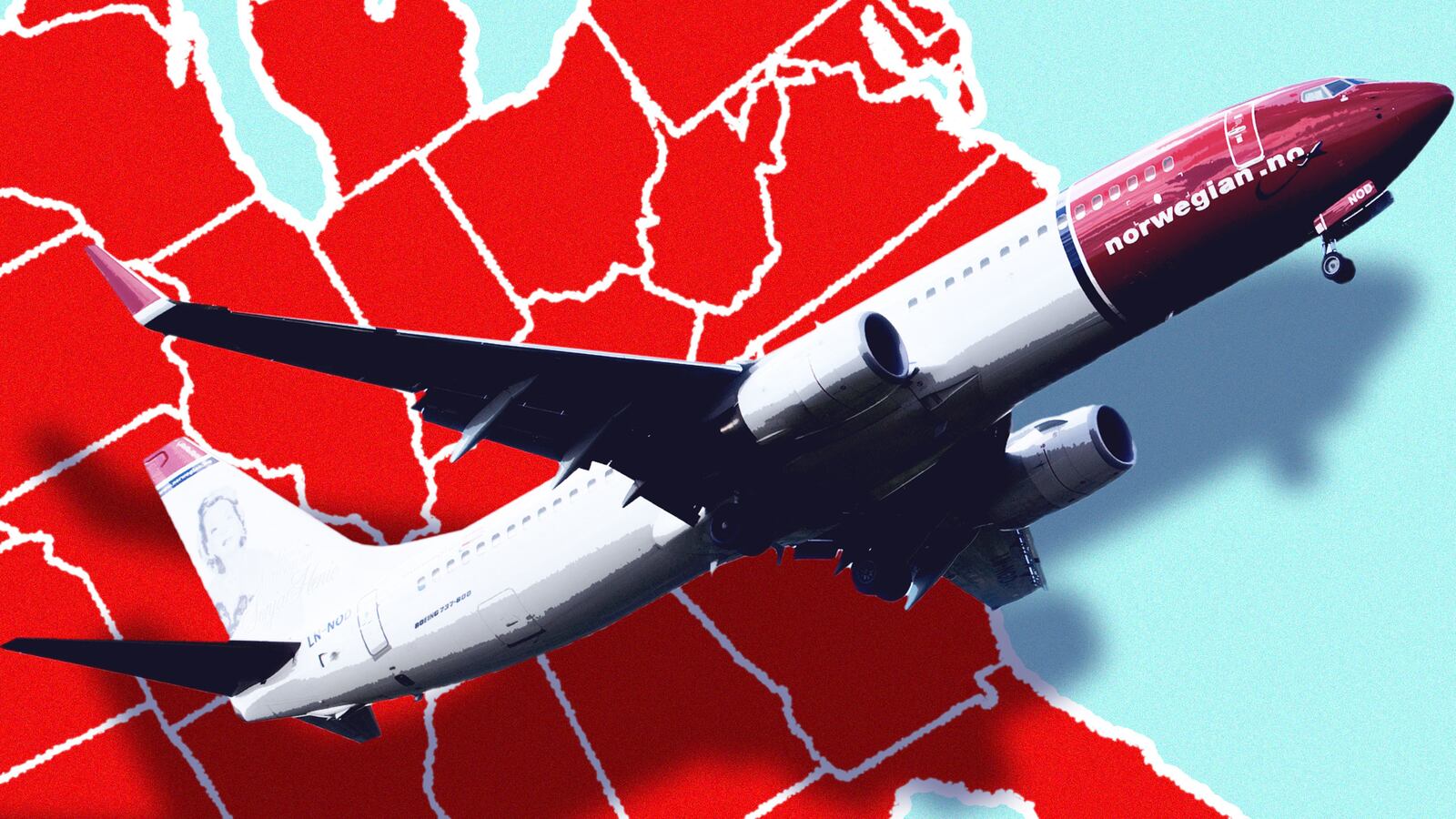LONDON—Flying the Atlantic between America and Europe shouldn’t be the big deal it still seems to be, but an aura lingers. It was the first great leap made as aviation began to shrink the globe, and some of that heritage clings to the imagination. The reality is, however, that most of the world is now served by a network of routes involving longer distances, some much longer and far more exotic.
But history confers an advantage to the airlines that pioneered flying the pond and we, the passengers, end up paying for that. Almost 80 percent of transatlantic traffic is controlled by Delta, United, and American, together with their European partners like British Airways, Iberia, Virgin Atlantic, and Alitalia. They would like to keep it that way, but there is a new competitor in the game.
Norwegian Air International, regardless of its name, is based in Ireland. And what’s really interesting about their strategy is not just that it aims to bring budget prices to every flight but that it may finally break the grip of the idea that there’s always a premium to be paid simply because an airline has been flying across the Atlantic since the 1950s.
The role played by Ireland in this is pivotal. The three major American carriers, American, Delta, and United, who have fought to keep Norwegian out of U.S. air space (so far unsuccessfully), have claimed that by registering the airline in Ireland rather than Norway allows Norwegian to take advantage of Ireland’s far lower corporate taxes, as well as copying the low wages model of Europe’s largest budget airline, Ryanair, an Irish enterprise. Naturally, the unions working for those U.S. airlines are supporting that same attack.
That may all be true, but Norwegian is smarter than that. They are exploiting Ireland’s geographical advantage as a gateway destination for Europe. Flying between North America and Ireland cuts at least an hour off the flight time to U.K. airports and at least two hours off flight times to European capitals. On the faster eastbound flights that means only five hours, similar to flying between the two coasts in America and a difference that shows up in less fatigue and jet lag.
That’s not just a geographical expedient. Ireland isn’t simply a country to pass through on your way to somewhere else. It’s one of Europe’s most engaging destinations that has become as sophisticated as any in delivering high quality hotels and restaurants, not to mention its natural appeal to golfers, fishermen, and equestrians. Both Cork and Shannon airports are close to places of gob-smacking beauty. Moreover, many Americans have Irish lineage.
A major part of the lock that the American and European legacy airlines have on North Atlantic routes is their control of the gates at the major hubs. London’s Heathrow, for example, normally operating at 99 percent of its capacity, has no gates available for airline newcomers even if they were ready to pay that airport’s stiff fees.
Like all other budget airlines, Norwegian has worked around this lockout by using airports where gates are available. Since 2014 Norwegian has been flying to the United States out of London’s Gatwick airport, where the gates were to be had and the airport fees are lower than at Heathrow. They serve New York, Boston, Fort Lauderdale, Orlando, Las Vegas, Los Angeles, and Oakland.
As well as undercutting British Airways on long-haul fares from Gatwick, Norwegian flies only Boeing 787 Dreamliners, an airplane that regular long-haul passengers prefer because of its superior cabin environment, particularly noticeable in the way it diminishes the effects of jet lag. These flights include premium economy class with round-trip fares of around $1,120 that are attracting business class passengers.
But at peak summer times the price difference between Norwegian and other airlines flying out of Gatwick has been marginal. Norwegian passengers have to pay extra for pre-chosen seats, food, and baggage and when that is added to the peak time price it more or less matches what you pay on an airline where those things are free—on some dates checked by online bookers Virgin Atlantic from Heathrow was actually cheaper.
The new routes to Ireland this summer are different. They are based on a more utilitarian model, offering bare bones fares without any extras for as little as $100 eastbound and $200 westbound (a difference explained by higher European airport fees). They will fly into Belfast (Northern Ireland), Dublin, Shannon, and Cork. (There are also flights to Edinburgh.) And they are different in another way that you will feel with your butt.
They won’t have the cabin comforts of the twin-aisle Dreamliner. Instead, passengers will find the familiar narrow tube of the ubiquitous Boeing 737, albeit a new iteration called the 737Max. The Max could well stand for maximum profits, minimum room. The dimensions of the 737’s cabin, and critically its width, were fixed when the airplane was designed in 1968, and even though a kind of trompe l’loeil remodeling of the cabin, including easier to use luggage bins and other details have improved the look the seats remain very tight and a serious challenge for anyone weighing more than 180 pounds.
But Norwegian’s biggest gamble is their choice of departure airports—Stewart in New York (at least 90 minutes north of Manhattan); Bradley International at Hartford in Connecticut; and T.F. Green airport at Providence, Rhode Island. There are inherent virtues in each of these airports. Given their potential capacity, they are under-used. Time spent going through security should be a breeze compared to the New York and New Jersey experience. And for people who don’t actually live in New York, or Boston, getting out of town is not a hurdle.
But reverse the view: Europeans flying into these airports face costly rides to reach the major tourist destinations. This is a familiar gambit of budget airlines, the destination that isn’t: Ryanair, for example, once listed Frankfurt as a destination, whereas the actual airport they used was 75 miles from Frankfurt. There is a virtue in off-center airports if they have a natural local market, like Westchester, New York, and of those selected by Norwegian Bradley already has good services to other airports in the U.S. The test will be whether Europeans feel happy about being off-center when they land.
Norwegian’s strategy is the creation of Bjorn Kjos, a 70-year-old former fighter pilot, the airline’s chief executive. He is following a long line of airline chiefs who have tried to break the stranglehold of the legacy airlines. These include Richard Branson, who had to overcome a long and dirty war with British Airways before Virgin Atlantic was accepted as a distinctive brand, eventually building its market on style rather than cheaper fares, and Freddie Laker, who launched his Skytrain no-frills transatlantic airline in 1977 after several years of vicious opposition from other airlines. His opponents never relented, and after several years Laker went bankrupt, a true visionary who more than any other had really proved the model for budget airlines.
But the first to challenge the regime of tightly-rigged fares over the Atlantic was actually an American aviation legend, Juan Trippe, the creator and czar of Pan Am.
When passenger flights over the pond resumed after World War II the fares and even the number of seats were dictated by a body representing all international airlines, the International Air Transport Association, IATA. It was at that time a cartel dominated by Europeans who insisted that the air travel business model should be based on it being a naturally elitist privilege, and people who wanted to cross the Atlantic cheaply should go steerage in one of the ocean liners.
Trippe introduced the first tourist class fare from New York to London, cutting the round-trip price by more than half, to $275, but the British closed their airports to Pan Am flights with tourist seats, forcing him to land in Shannon. Thwarted in Europe, Trippe brought the same value to flights between New York and San Juan, Puerto Rico, where the one-way fare was $75 and the flights were packed.
It was not until 1952 that Trippe’s incessant bombardment of IATA forced all the airlines to accept the concept of a tourist fare. That summer Pan Am introduced a round-trip fare of $486 between New York and London. That’s the equivalent of $2,200 today, and so it still remained beyond the reach of many travelers, but it was the first step in a revolution, largely pushed by Trippe, to democratize air travel.
And it may well be that Norwegian is the harbinger of another step change in making travel between North America and Europe more accessible. “It’s an interesting and challenging move into new terrain” says Craig Jenks, the president of a Airline/Aircraft Projects, an analyst based in New York.
Both the 787 and 737 Max have the latest generation of jet engines. They are between 15 and 20 percent more fuel efficient. The legacy airlines are still flying gas guzzlers across the Atlantic—British Airways, for example, flies 747s that are more than 20 years old. This gives Norwegian an edge that combined with high-density seating (a polite phrase) is a far more competitive business model.
Jenks points out that three European airlines planning to respond to the Norwegian challenge by launching new long-haul budget airlines—IAG (the parent of British Airways and Iberia), Lufthansa, and Air France—will be using older, less efficient airplanes because of long waiting lists for new generation jets.
These days, when an airline chief considers buying a new airplane, he’s not actually looking at an airplane, he’s looking at a business model. There is none of the romance associated with pioneering the original routes in this calculation. Algorithms dictate optimum capacity for each route and the fares that ensure a profit.
It’s a relatively simple equation: what is the most efficient way to fly X number of seats a specific distance? This is calculated down to the last penny. It determines every feature of an airplane as it is designed. It applies whether the airplane is sized to fly the longest transoceanic routes or between North America and Ireland, which in the reality of now is almost like a short bus journey for which the only technical challenge is really how to pack ’em in and sell ’em cheap. Using this formula, can Air Walmart be far behind?






